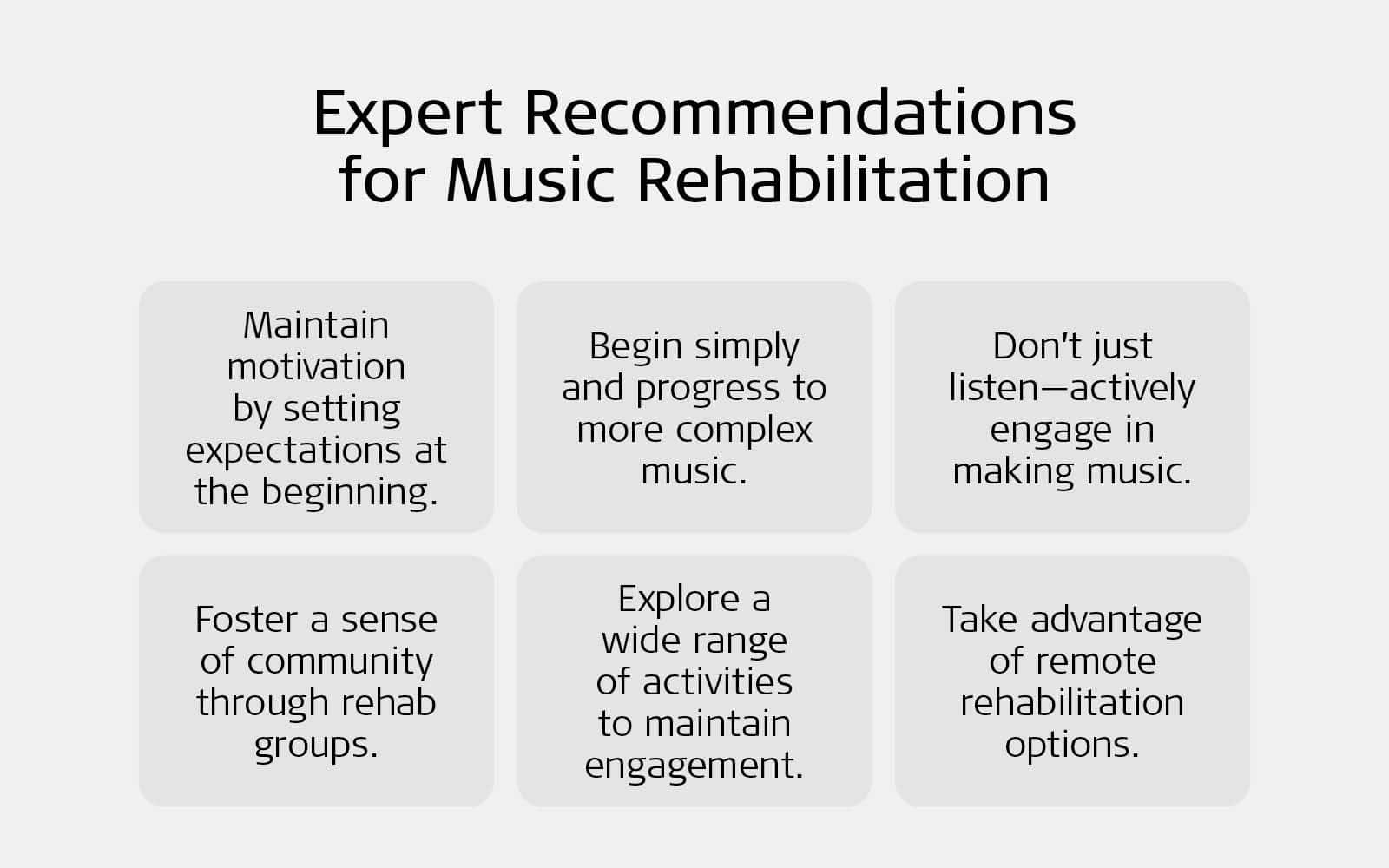Deepthi Mahadevappa, Christina Prodinger
Published Dec 04, 2023
A Guide to Music Rehabilitation for Adult Cochlear Implant Recipients
Many of us take music and the benefits it has in our lives for granted. Music can positively impact many aspects of life, including physical health, emotional well-being, social relationships, and the rehabilitation journey of hearing implant recipients. It can lift mood and alleviate negative emotions such as stress and anxiety. It is therefore important for hearing implant recipients to be able to hear and appreciate music.

The benefits of music training extend beyond improving quality of life. Active engagement with music, like learning song lyrics, can improve speech understanding, which is essential for effective daily communication.Slater, J., Skoe, E., Strait, D.L., O‘Connell, S., Thompson, E., & Kraus, N. (2015). Music training improves speech-in-noise perception: Longitudinal evidence from a community-based music program. Behavioral Brain Research, 291, 244-252.[1]Smith, L., Bartel, L., Joglekar, S., & Chen, J. (2017). Musical rehabilitation in adult cochlear implant recipients with a self-administered software. Otology & Neurotology, 38(8), 262–267.[2] Furthermore, music may improve cognitive and linguistic skills, including auditory attention and phonological processing. These language-related improvements can also make communication easier.
Additionally, listening to or actively engaging with music has the potential to improve episodic and short-term memory and increase the ability to resist distractions.Kraus, N., & Chandrasekaran, B. (2010). Music training for the development of auditory skills. Nature Reviews Neuroscience, 11, 599–605.[3]Musacchia, G., Sams, M., Skoe, E., & Kraus, N. (2007). Musicians have enhanced subcortical auditory and audiovisual processing of speech and music. Proceedings of the National Academy of Sciences of the United Stated of America, 104(40), 15894–15898.[4]Musacchia, G., Strait, D., & Kraus, N. (2008). Relationships between behavior, brainstem and cortical encoding of seen and heard speech in musicians, Hearing Research, 241, 34–42.[5]Shahin, A.J. (2011). Neurophysiological influence of musical training on speech perception. Frontiers in Psychology, 2, 126.[6]Wong, P.C., Skoe, E., Russo, N.M., Dees, T., & Kraus, N. (2007). Musical experience shapes human brainstem encoding of linguistic pitch patterns. Nature Neuroscience, 10(4), 420– 422.[7]
How Music Training Can Help
The benefits of music training do not just apply to normal hearing individuals; studies have shown improved musical perception and quality of life after music training by cochlear implant users as well. Calvino, M., Gavilán, J., Sánchez-Cuadrado, I., Pérez-Mora, R.M., Muñoz, E., Díez-Sebastián, J., & Lassaletta, L. (2015). Using the HISQUI29 to assess the sound quality levels of Spanish adults with unilateral cochlear implants and no contralateral hearing. European Archives of Oto-Rhino-Laryngology, 273, 2343-53.[8]Looi, V., & She, J. (2010). Music perception of cochlear implant users: A questionnaire, and its implications for a music training program. International Journal of Audiology, 49 (2), 116–28.[9] There is no single music genre, rhythm, or melody that is ideal for music rehabilitation—music in general has the potential to positively affect overall quality of life. And there are ways for cochlear implant recipients to work with whatever type of music they like most. Using music as a tool to improve listening and communication skills as well as quality of life is a valuable element in hearing implant rehabilitation programs.

Improving Quality of Life with Music Rehabilitation
If you’re a hearing professional looking for a resource that will guide you along the music rehabilitation journey, “Music Rehabilitation for Adult Cochlear Implant Recipients“ is what you are looking for. This comprehensive resource tailored to your needs is designed to assist hearing professionals in supporting cochlear implant recipients through music rehabilitation:
- Getting Started: Learn when and how to start the music rehabilitation process and understand the essentials of music engagement. Set realistic expectations with your patients to help them stay motivated along their hearing journey.
- Focused Music Listening: Explore how to engage your recipients in focused music listening, enabling them to appreciate music, beginning with simpler music and progressing over time to more complex arrangements.
- Active Music Engagement: Find guidance on how to help your recipients to actively participate in music, whether it’s playing an instrument, singing, or dancing. By practicing often and in a focused manner, they can explore the joy of creating music and increase their music perception and appreciation over time.
- Music Focus Groups: Learn how to create and lead music focus groups, fostering a sense of community and enabling cochlear implant recipients to share their musical experiences.
- Individual and Group Activities: Explore a wide range of music activities that can be carried out individually or in group settings, enhancing musical skills and enjoyment.
- Remote Music Activities: In an era of digital connectivity, discover tips for conducting music activities remotely, ensuring that music remains accessible and enjoyable, even from a distance. Learn tips to keep sessions person-centered and engaging despite not being conducted in person.
“Music Rehabilitation for Adult Cochlear Implant Recipients” is available to download for free. And learn more about our rehabilitation resources with this course.
If you would like further information and resources to add music to your rehabilitation with cochlear implant recipients, read more about music resources for children with cochlear implants, and let your patients know about Meludia.
They can try Meludia for free with their myMED-EL account.* And if they don’t have a myMED-EL account yet, it’s free to sign up for one. Take a look at this article to learn more about music rehabilitation and Meludia.
*Offer unavailable in Japan for legal reasons.
References
-
[1]
Slater, J., Skoe, E., Strait, D.L., O‘Connell, S., Thompson, E., & Kraus, N. (2015). Music training improves speech-in-noise perception: Longitudinal evidence from a community-based music program. Behavioral Brain Research, 291, 244-252.
-
[2]
Smith, L., Bartel, L., Joglekar, S., & Chen, J. (2017). Musical rehabilitation in adult cochlear implant recipients with a self-administered software. Otology & Neurotology, 38(8), 262–267.
-
[3]
Kraus, N., & Chandrasekaran, B. (2010). Music training for the development of auditory skills. Nature Reviews Neuroscience, 11, 599–605.
-
[4]
Musacchia, G., Sams, M., Skoe, E., & Kraus, N. (2007). Musicians have enhanced subcortical auditory and audiovisual processing of speech and music. Proceedings of the National Academy of Sciences of the United Stated of America, 104(40), 15894–15898.
-
[5]
Musacchia, G., Strait, D., & Kraus, N. (2008). Relationships between behavior, brainstem and cortical encoding of seen and heard speech in musicians, Hearing Research, 241, 34–42.
-
[6]
Shahin, A.J. (2011). Neurophysiological influence of musical training on speech perception. Frontiers in Psychology, 2, 126.
-
[7]
Wong, P.C., Skoe, E., Russo, N.M., Dees, T., & Kraus, N. (2007). Musical experience shapes human brainstem encoding of linguistic pitch patterns. Nature Neuroscience, 10(4), 420– 422.
-
[8]
Calvino, M., Gavilán, J., Sánchez-Cuadrado, I., Pérez-Mora, R.M., Muñoz, E., Díez-Sebastián, J., & Lassaletta, L. (2015). Using the HISQUI29 to assess the sound quality levels of Spanish adults with unilateral cochlear implants and no contralateral hearing. European Archives of Oto-Rhino-Laryngology, 273, 2343-53.
-
[9]
Looi, V., & She, J. (2010). Music perception of cochlear implant users: A questionnaire, and its implications for a music training program. International Journal of Audiology, 49 (2), 116–28.
References


Deepthi Mahadevappa
Deepthi Mahadevappa (Ph.D.) is a speech language pathologist currently working as a rehabilitation manager at MED-EL headquarters in Innsbruck, Austria. Dr. Mahadevappa has many years of experience working in the field of hearing loss in clinical and educational settings. At present, she contributes to the development of digital rehabilitation tools and supports rehabilitation professionals globally.
Christina Prodinger
Christina Prodinger, BA is an educational scientist currently dedicated to Masters program focusing on adult education and digital literacies. She has been with MED-EL for over a decade, and in her role as a Rehabilitation Assistant, she coordinates adaptations for rehabilitation resources.
Was this article helpful?
Thanks for your feedback.
Sign up for newsletter below for more.
Thanks for your feedback.
Please leave your message below.
CTA Form Success Message
Send us a message
Field is required
John Doe
Field is required
name@mail.com
Field is required
What do you think?
The content on this website is for general informational purposes only and should not be taken as medical advice. Please contact your doctor or hearing specialist to learn what type of hearing solution is suitable for your specific needs. Not all products, features, or indications shown are approved in all countries.


Deepthi Mahadevappa
Deepthi Mahadevappa (Ph.D.) is a speech language pathologist currently working as a rehabilitation manager at MED-EL headquarters in Innsbruck, Austria. Dr. Mahadevappa has many years of experience working in the field of hearing loss in clinical and educational settings. At present, she contributes to the development of digital rehabilitation tools and supports rehabilitation professionals globally.
Christina Prodinger
Christina Prodinger, BA is an educational scientist currently dedicated to Masters program focusing on adult education and digital literacies. She has been with MED-EL for over a decade, and in her role as a Rehabilitation Assistant, she coordinates adaptations for rehabilitation resources.

Deepthi Mahadevappa
Deepthi Mahadevappa (Ph.D.) is a speech language pathologist currently working as a rehabilitation manager at MED-EL headquarters in Innsbruck, Austria. Dr. Mahadevappa has many years of experience working in the field of hearing loss in clinical and educational settings. At present, she contributes to the development of digital rehabilitation tools and supports rehabilitation professionals globally.

Christina Prodinger
Christina Prodinger, BA is an educational scientist currently dedicated to Masters program focusing on adult education and digital literacies. She has been with MED-EL for over a decade, and in her role as a Rehabilitation Assistant, she coordinates adaptations for rehabilitation resources.



